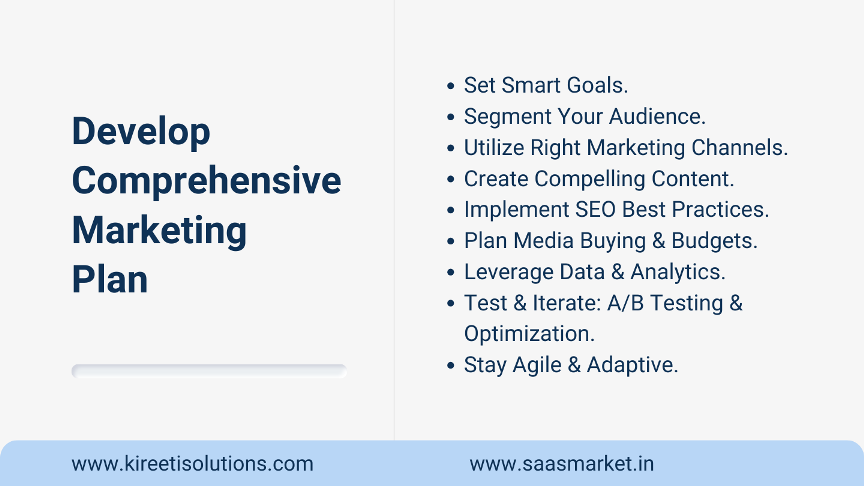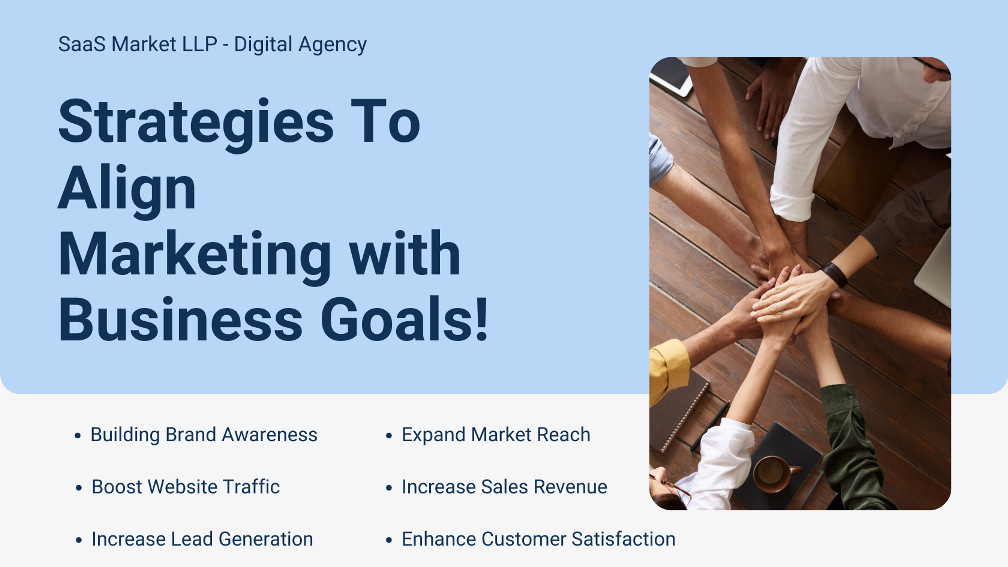In this blog post, we shall discuss about Business Goals, which needs to be aligned with Marketing Efforts.
In today’s dynamic business landscape, achieving success requires more than just a great product or service. It demands a well-thought-out marketing strategy that aligns seamlessly with the overarching objectives of the business.
Whether you’re a B2B or B2C company operating in any industry, understanding how to synchronize your marketing efforts with your business goals is paramount.
In this comprehensive guide, we’ll explore proven strategies to ensure your marketing initiatives propel your business towards its objectives effectively.
Understanding the Importance of Aligning Marketing with Business Goals
Before delving into specific strategies, it’s crucial to grasp why aligning marketing with business goals is essential. Marketing serves as the bridge between your brand and your target audience, influencing their perceptions, behaviors, and ultimately, their purchasing decisions.
When marketing efforts are closely tied to business objectives, every campaign, initiative, and tactic becomes purposeful and impactful.
This alignment ensures that resources are allocated efficiently, maximizing ROI and driving sustainable growth.
Identifying Your Business Goals!
The first step in aligning marketing with business goals is to clearly define and prioritize your objectives. Business goals can vary widely depending on factors such as industry, company size, and stage of growth. Common business goals include:
- Building Brand Awareness: Increasing visibility and recognition of the brand among the target audience. Building brand awareness (Business Branding Strategy) is crucial for businesses to establish a strong presence in the market. Through strategic marketing initiatives, businesses can increase visibility, engage with their target audience, and create lasting impressions. Consistent branding across various channels helps in building recognition and credibility, ultimately driving growth and success.
- Improving Product / Service Awareness: Educating potential customers about the features, benefits, and value propositions of products or services. Improving product or service awareness involves implementing targeted marketing strategies to effectively communicate the value proposition to the target audience. Utilizing various channels such as social media, email marketing, and content marketing helps in educating consumers about the features, benefits, and solutions offered, thereby increasing product/service visibility and recognition.
- Boosting Website Traffic: Driving more visitors to the company website to improve online visibility and engagement. Boosting website traffic involves implementing various digital marketing tactics such as search engine optimization (SEO), content marketing, social media marketing, email marketing, and Paid Advertising (Performance Marketing) . By optimizing website content, engaging with the audience on social media, and driving targeted traffic through ads, businesses can effectively increase website traffic and reach their target audience.
- Increasing Lead Generation: Attracting potential customers and initiating interest in products or services. Increasing lead generation involves implementing strategic tactics such as optimizing landing pages, creating compelling content offers, utilizing lead magnets, running targeted advertising campaigns, and optimizing conversion paths. By focusing on these strategies, businesses can attract more qualified leads (Inbound Lead Generation) and drive growth in their sales pipelines.
- Enhancing Customer Satisfaction: Ensuring positive customer experiences at every touchpoint to increase satisfaction and advocacy. Enhancing customer satisfaction requires businesses to prioritize customer feedback, offer personalized support, streamline processes, and consistently deliver high-quality products or services. By listening to customer needs, addressing concerns promptly, and exceeding expectations, businesses can foster loyalty and build lasting relationships with their customers.
- Increasing Sales Revenue: Driving revenue growth through increased sales and customer acquisition. Increasing sales revenue involves implementing effective sales strategies, optimizing pricing, expanding market reach, and enhancing customer experience. By identifying target markets, nurturing leads, and providing value-added services, businesses can drive sales growth. Additionally, leveraging data analytics and adopting innovative sales techniques can further boost revenue generation.
- Expanding Market Reach: Entering new markets or demographics to reach a broader audience. Expanding market reach is crucial for business growth. By leveraging digital marketing channels, such as Social Media, SEO, and PPC advertising, companies can reach a broader audience. Engaging in strategic partnerships, attending industry events, and exploring new geographical markets are also effective ways to expand market reach and attract potential customers.
- Enhancing Customer Retention: Fostering long-term relationships with existing customers to encourage repeat purchases and loyalty. Enhancing customer retention involves delivering exceptional experiences, personalized communication, and proactive customer support. Implementing loyalty programs, gathering feedback, and addressing customer concerns promptly can foster long-term relationships. Providing value-added services and maintaining regular engagement through newsletters or exclusive offers also contribute to retaining satisfied customers.
- Building Thought Leadership: Establishing the brand as an authority in the industry by sharing valuable insights and expertise. Building thought leadership involves sharing valuable insights, industry expertise, and innovative ideas through content creation, public speaking, and networking. Consistently publishing high-quality articles, participating in industry events, and engaging with peers can establish credibility, foster trust, and position individuals or brands as authoritative voices in their field.
- Measuring and Analyzing Marketing ROI: Tracking and evaluating the effectiveness of marketing efforts in achieving Business Objectives. Measuring and analyzing marketing ROI involves tracking the Performance of Marketing campaigns, assessing their impact on key metrics such as sales, leads, and Brand Awareness, and calculating the return on investment. By analyzing data from various channels, marketers can identify successful strategies, optimize future efforts, and allocate resources effectively.
Once you’ve identified your business goals, you can tailor your marketing strategies to address each objective effectively.

Align Marketing with Business Objectives
Now, let’s explore proven strategies to align your marketing efforts with your business goals:
Develop a Comprehensive Marketing Plan
Start by creating a detailed marketing plan that outlines your objectives, target audience, messaging, channels, and tactics.
Ensure that each component of your plan is aligned with your business goals and supports your overarching strategy.
Developing a comprehensive marketing plan involves defining business objectives, identifying target audiences, conducting Market Research, and outlining strategies for product positioning, pricing, promotion, and distribution.
It also includes setting measurable goals, establishing budgets, and implementing tactics to achieve desired outcomes while adapting to market dynamics.
Set SMART Goals
When setting marketing goals, follow the SMART criteria—Specific, Measurable, Achievable, Relevant, and Time-bound. This approach ensures that your goals are clear, quantifiable, realistic, and aligned with your business objectives.
Setting SMART goals involves creating objectives that are Specific, Measurable, Achievable, Relevant, and Time-bound. This approach helps ensure clarity and focus, facilitates tracking progress, enhances motivation, and increases the likelihood of success.
By setting SMART goals, individuals and organizations can effectively plan and execute their strategies to achieve desired outcomes.
Segment Your Audience
Understand your target audience’s needs, preferences, and behaviors by segmenting them into distinct groups.
This allows you to personalize your marketing messages and campaigns to resonate with each segment effectively.
Segmenting your audience involves dividing your target market into distinct groups based on shared characteristics such as demographics, behaviors, or preferences. This enables personalized messaging and tailored marketing strategies, leading to more effective engagement and higher conversion rates.
By understanding and catering to the needs of different audience segments, businesses can optimize their marketing efforts.
Utilize the Right Marketing Channels
Identify the most effective marketing channels to reach your target audience based on their preferences and behavior.
Whether it’s social media, Email Marketing, content marketing, paid advertising, or a combination of channels, choose the platforms that align with your business goals and yield the best results.
Utilizing the right marketing channels is crucial for reaching your target audience effectively. Whether it’s Social Media, email marketing, SEO, or PPC advertising (Performance Marketing), selecting the appropriate channels ensures maximum visibility and engagement.
By understanding where your audience is most active, you can allocate resources wisely and achieve better results for your campaigns.
Create Compelling Content
Develop high-quality, relevant content that addresses the pain points, interests, and aspirations of your target audience. Whether it’s blog posts, videos, infographics, or case studies, your content should provide value, educate, entertain, or inspire your audience while driving them towards your business goals.
Creating compelling content is essential for engaging your audience and driving action. By crafting content that resonates with your target audience’s needs and interests, you can capture their attention and inspire them to take the desired action.
Whether it’s through blog posts, videos, or social media posts, compelling content leaves a lasting impression and fosters meaningful connections.
Implement SEO Best Practices
Optimize your website and content for search engines to improve visibility, drive organic traffic, and generate leads.
Conduct keyword research, optimize meta tags and descriptions, create valuable content, and build quality backlinks to enhance your search engine rankings and align with your business goals.
Implementing the best SEO practices is crucial for boosting your website’s visibility and driving organic traffic.
By optimizing your website’s structure, content, and meta tags, you can improve its search engine ranking and attract more visitors. Additionally, focusing on quality backlinks and mobile optimization can further enhance your SEO efforts.
Leverage Data and Analytics
Continuously monitor and analyze key performance indicators (KPIs) to track the effectiveness of your marketing efforts in achieving your business goals.
Use data-driven insights to identify trends, measure ROI, and optimize your strategies for better results.
Leveraging data and analytics is essential for making informed decisions in your marketing strategy. By Analyzing Metrics like Website Traffic, User Engagement, and Conversion Rates, you can identify trends, understand customer behavior, and optimize your campaigns for better results.
This data-driven approach ensures efficiency and effectiveness in your marketing efforts.
Test and Iterate
Experiment with different marketing tactics, messages, and channels to determine what resonates best with your target audience.
Continuously test, measure, and iterate your campaigns based on performance data to optimize results and align with your business goals effectively.
Testing and iteration are vital components of any Successful Marketing Strategy. By experimenting with different approaches, analyzing the results, and refining your tactics based on insights, you can continuously improve your campaigns’ effectiveness.
This iterative process allows you to adapt to changing market dynamics and customer preferences, maximizing your overall impact.
Align Sales and Marketing Efforts
Foster collaboration and alignment between your sales and marketing teams to ensure a cohesive approach towards achieving business objectives. Encourage communication, share insights, and establish shared goals to maximize efficiency and effectiveness.
Aligning sales and marketing efforts is essential for maximizing business success. By ensuring both teams work together seamlessly, you can create a unified approach to attracting and converting leads.
This alignment improves communication, enhances customer experience, and ultimately drives revenue growth by aligning strategies and goals towards common objectives.
Stay Agile and Adaptive
In today’s fast-paced business environment, flexibility and adaptability are key. Stay abreast of industry trends, consumer preferences, and market dynamics. This will help to adjust your Marketing-Business Strategies accordingly & to stay aligned with your evolving business goals.
Staying agile and adaptive in today’s dynamic business landscape is crucial for maintaining relevance and competitiveness. By embracing change, continuously refining strategies, and swiftly responding to market shifts is needed.
Businesses can effectively navigate uncertainties and capitalize on emerging opportunities, ensuring sustained growth and resilience in the long run.
Conclusion
Aligning your marketing efforts with your business goals is essential for driving Sustainable Growth and Success. By clearly defining your objectives, developing tailored strategies, and continuously monitoring and optimizing your campaigns, you can ensure that your marketing initiatives propel your business towards its goals effectively.
With the right approach and execution, you can achieve remarkable results and establish your brand as a leader in your industry.
Contact SaaS Market LLP Team for further support:
